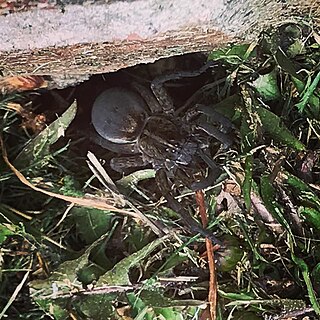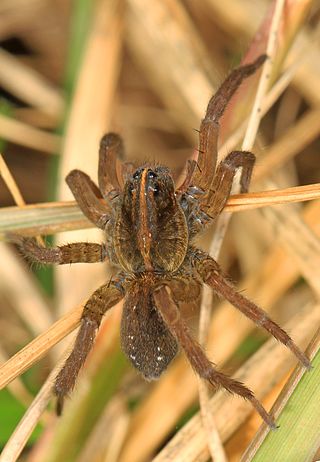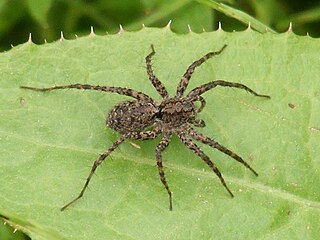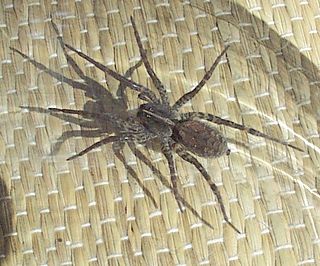
Wolf spiders are members of the family Lycosidae. They are robust and agile hunters with excellent eyesight. They live mostly in solitude, hunt alone, and usually do not spin webs. Some are opportunistic hunters, pouncing upon prey as they find it or chasing it over short distances; others wait for passing prey in or near the mouth of a burrow.

Tigrosa aspersa is a large wolf spider that inhabits the eastern United States. Compared to its close relative Tigrosa helluo, T. aspersa is much larger. This species was known as Hogna aspersa prior to 2012, when it was moved to Tigrosa.
Nukuhiva is a genus of spiders with a single species, Nukuhiva adamsoni, that occurs only on the Marquesas Islands in French Polynesia. It is in the wolf spider family, Lycosidae. It has been found on Nuku Hiva and on Ua Huka, a smaller island about 25 km (16 mi) to the east.
Hogna ericeticola, known as the rosemary wolf spider, is a species of spider in the family Lycosidae. It is endemic to Florida, in the United States.

The Artoriinae are a subfamily of wolf spiders. The monophyly of the subfamily has been confirmed in a molecular phylogenetic study, although the relationships among the subfamilies was shown to be less certain.

Artoriopsis expolita is a species of wolf spider from southern Australia, first described in 1877 by Ludwig Koch as Lycosa expolita.

Hogna carolinensis, commonly known as the Carolina wolf spider and giant wolf spider, is found across North America. It is the largest of the wolf spiders in North America, typically measuring at 18–20 mm for males and 22–35 mm for females.

Tigrosa helluo is a species of spider belonging to the family Lycosidae, also known as wolf spiders. T. helluo was formerly known as Hogna helluo before differences between dorsal color patterns, habitat preferences, body structures, etc. were discovered. The species is native to the United States, Canada, and Mexico. It can be found across the eastern half of the United States, primarily in the Northeast and New England, and as far west as Nebraska and Kansas. T. helluo can be found in diverse habitats including woods, marshes, fields, and riparian areas. Typically, members of this species prefer to live in wetter areas as opposed to dry environments. Males tend to live for around a year and females will live for close to two years.

Tigrosa is a genus of spiders in the family Lycosidae, found in North America.

Hogna lenta is a species of wolf spider in the family Lycosidae. It is found in the USA.
Hogna baltimoriana is a species of wolf spider in the family Lycosidae. It is found in the USA and Canada.

Hogna antelucana is a species of wolf spider in the family Lycosidae. It is found in the United States.
Hogna coloradensis is a species of wolf spider in the family Lycosidae. It is found in the United States and Mexico.

Pardosa milvina, the shore spider, is a species in the wolf spider family. They are mainly found near rivers and in agricultural areas in eastern North America. P. milvina feed on a large variety of small insects and spiders. Ground beetles such as Scarites quadriceps and large wolf spiders such as Tigrosa helluo are predators of P. milvina. P. milvina are smaller spiders with thin, long legs. This species captures prey such as arthropods with their legs and then kills them with their venom. Their predators are larger wolf spiders and beetles. P. milvina are able to detect these predators from chemotactile and vibratory cues. These spiders lose limbs when escaping from predators and they can change their preferred location in order to avoid predators. P. milvina also use chemical cues in order to mate. During their mating ritual, the male raises his legs and shakes his body. Both males and females can use silk, a chemotactile cue, for sexual communication. Additionally, female shore spiders heavily invest in their offspring, keeping them in egg sacs and carrying them for a few weeks after they are born.

Hogna frondicola is a species of wolf spider in the family Lycosidae. It is found in the United States and Canada.

Venator marginatus is a wolf spider, endemic to Australia and found in Victoria.
Halocosa is a genus of wolf spiders first described by G. N. Azarkina and L. A. Trilikauskas in 2019. As of December 2021 it contains only three species: H. cereipes, H. hatanensis, and H. jartica. The type species, Halocosa cereipes, was originally described under the name "Lycosa cereipes".
Serratacosa is a genus of wolf spiders. It was first described by L. Y. Wang, X. J. Peng and Z. S. Zhang in 2021, and it has only been found in China. As of January 2022 it contains only three species: S. himalayensis, S. medogensis, and S. multidontata.
Anomalosa oz is a spider in the Lycosidae family. It was first described in 2006 by Volker Framenau.
Anomalosa kochi is a spider in the Lycosidae family. It was first described in 1898 by Eugène Simon as Anomalomma kochi. In 1960, it was transferred to the genus Anomalosa by Carl Friedrich Roewer. The current description is given by Volker Framenau.










